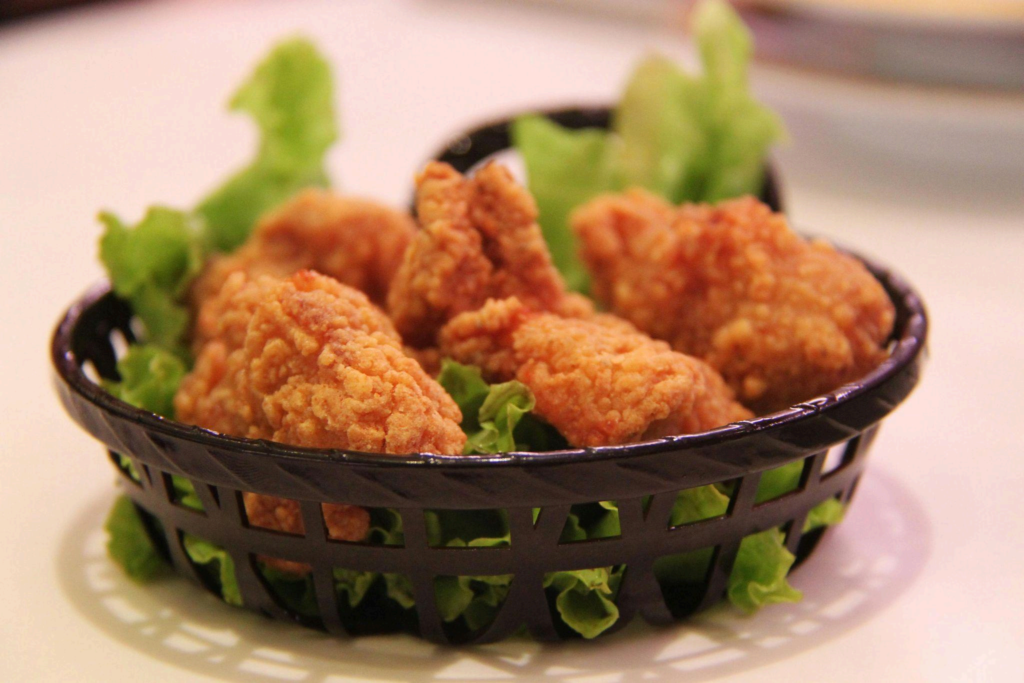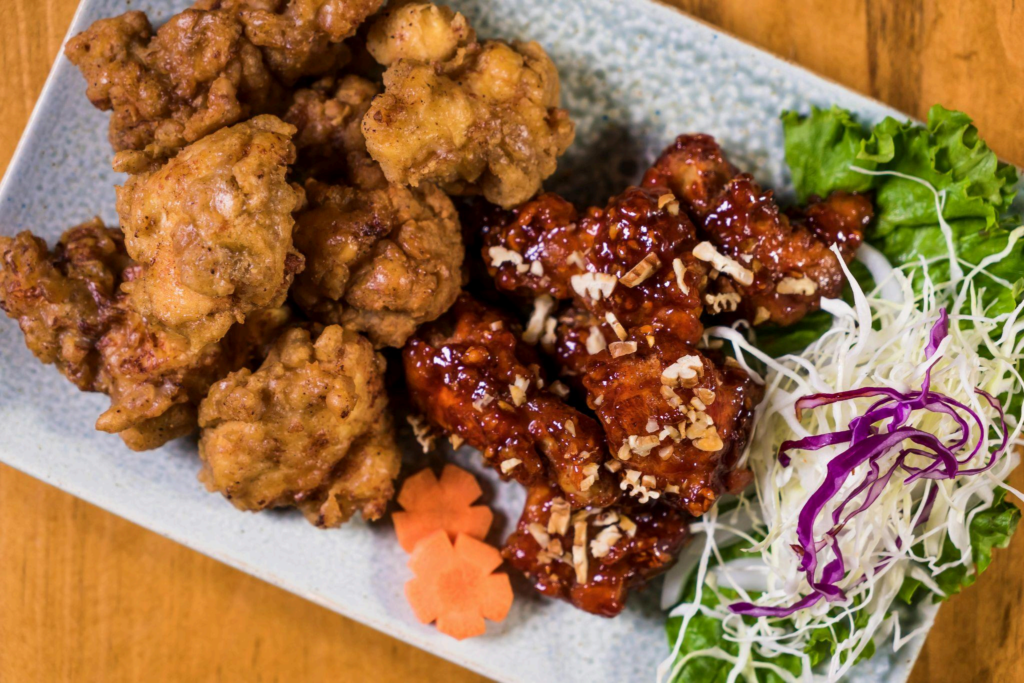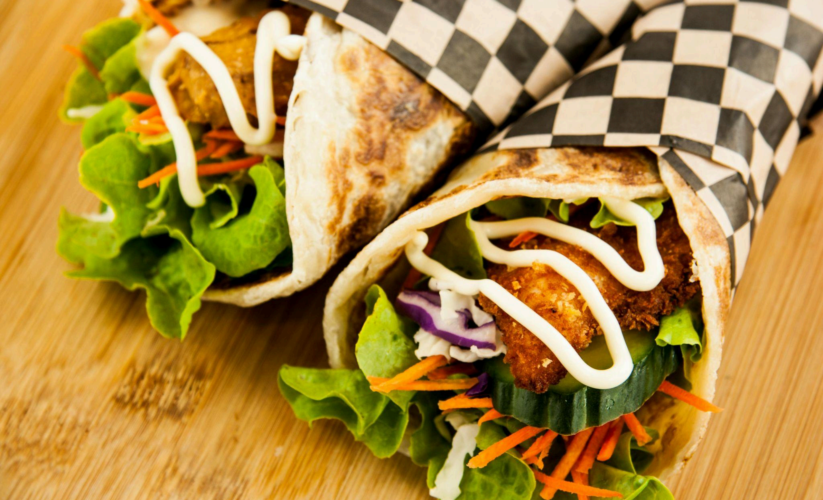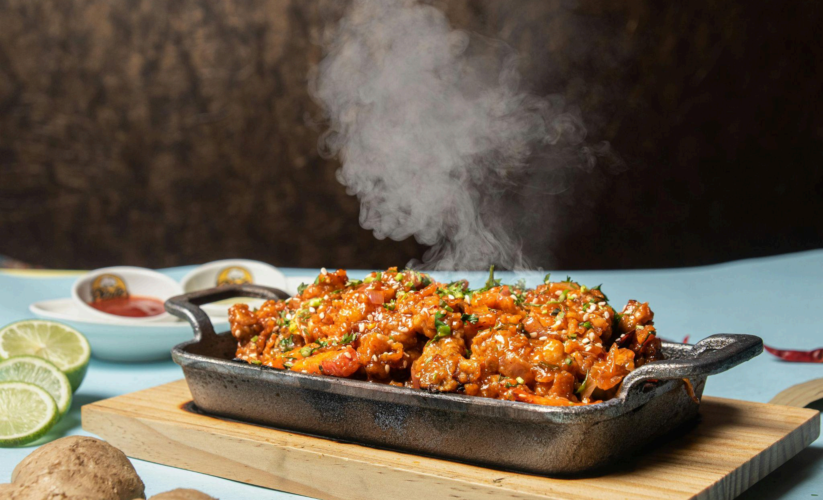Korean Fried Chicken (Crispy & Savory)
Introduction
Korean Fried Chicken has taken the global culinary scene by storm. It is beloved for its
signature crispy exterior and mouthwatering balance of sweet, spicy, and savory flavors. In
its homeland of South Korea, fried chicken culture is so widespread that you’ll find numerous
variations, from ultra-spicy Yangnyeom chicken to soy-garlic and even cheese-seasoned
styles. Regardless of the flavor profile, Korean Fried Chicken typically features a paper-thin
crust achieved through a special double-frying method, ensuring that each bite remains
crunchy, even after it’s coated with sauce.
This recipe outlines how to create that distinctive, crispy crust right in your home kitchen,
along with a tangy, spicy-sweet sauce. You’ll also find tips on selecting the right chicken cuts,
seasoning, and frying techniques to replicate (or even surpass) your favorite Korean fried
chicken spot. Once you master this dish, you’ll understand why it’s a staple for everything
from late-night snacking to festive gatherings in Korea.
Why You’ll Love This Recipe
1. Extra Crispy Crust: Learn the secrets behind double-frying and special batters for
that crackly, wafer-thin exterior.
2. Bold & Balanced Flavors: Experience the sweet, spicy, and savory depth of the
classic Korean fried chicken sauce.
3. Versatile: Adjust the spice level to suit your preference, or swap in alternative sauces
like soy-garlic.
4. Meal-Prep Friendly: Marinate the chicken ahead, so you can fry at the last minute
for fresh, hot servings.
5. Global Crowd-Pleaser: Whether you’re serving a game-day spread, a party
appetizer, or a hearty dinner, Korean Fried Chicken is sure to delight everyone.
Ingredients
Chicken & Marinade● 2 pounds (about 900g) chicken wings or drumettes (you can also use boneless
thigh or breast strips)
● 1 teaspoon salt
● ½ teaspoon black pepper
● 2 tablespoons rice wine (mirin or sake also work; optional, for tenderizing)
● 1 teaspoon grated ginger (optional but recommended for flavor)
Dry Coating & Batter
● 1 cup all-purpose flour
● ½ cup cornstarch (or potato starch, often used in Korean frying)
● 1 teaspoon baking powder
● 1 teaspoon salt (adjust to taste)
● Cold water (about 1 cup, adjust to achieve a slightly thick yet pourable consistency)
Korean Fried Chicken Sauce (Yangnyeom Sauce)
● 2 tablespoons gochujang (Korean red chili paste)
● 2 tablespoons ketchup
● 2 tablespoons soy sauce
● 2–3 tablespoons brown sugar (adjust to taste for sweetness)
● 1 tablespoon honey or corn syrup (for added stickiness)
● 1 tablespoon minced garlic
● 1 teaspoon grated ginger
● 1 tablespoon rice vinegar (or apple cider vinegar)
● 2 tablespoons water
● 1 tablespoon sesame oil (for fragrance)For Frying & Garnish
● Vegetable oil or canola oil (enough to fill a pot or deep skillet about halfway)
● Toasted sesame seeds (optional)
● Thinly sliced green onions (optional)
Serving Suggestions
● Pickled radish (chikin mu), coleslaw, or simple green salad
● Steamed rice or fries
● Cold beer or a refreshing soft drink
Step-by-Step Instructions
Step 1: Marinate the Chicken
1. Pat Dry
Rinse your chicken pieces (if desired), then pat them dry thoroughly with paper
towels. Removing excess moisture helps produce a crispier texture when frying.
2. Season
Place the chicken in a large bowl. Sprinkle on 1 teaspoon of salt and ½ teaspoon
of black pepper, along with 2 tablespoons of rice wine and 1 teaspoon of grated
ginger (if using).

3. Toss & Rest
Use your hands or tongs to mix, ensuring each piece is coated. Cover and
refrigerate for at least 30 minutes or up to 2 hours.
Step 2: Prepare the Batter & Coating
1. Mix the Dry Ingredients
In a large bowl, whisk together 1 cup all-purpose flour, ½ cup cornstarch, 1
teaspoon baking powder, and 1 teaspoon salt.
2. Create a Batter
Gradually add cold water—starting with around ¾ cup—and stir until you get a
batter that’s slightly thicker than pancake batter. You may need a bit more or lesswater to reach the ideal consistency.
3. Conversation Tip
For an extra-crunchy crust, some Korean recipes involve dipping the marinated
chicken in the dry mix first, then in a separate wet batter. In this version, we’re
simplifying by creating a single batter. If you like, you can keep a little of the dry mix
aside to dust the chicken before it goes into the wet batter.
Step 3: Heat the Oil
1. Choose a Pot or Deep Skillet
Select a heavy-bottomed pot or deep fryer. Fill it about halfway with vegetable or
canola oil.
2. Heat to the Right Temperature
Using a thermometer, aim for 350°F (175°C). If you don’t have a thermometer, you
can drop a small piece of batter into the oil—if it sizzles and floats to the top almost
immediately, you’re good to go.
Step 4: First Fry (Par-Fry)
1. Coat the Chicken
Take each marinated chicken piece and dip it into the batter, allowing excess to drip
off. Carefully lower it into the hot oil.
2. Fry in Batches
Work in small batches so you don’t overcrowd the pot, as that lowers the oil
temperature. Cook the chicken for about 4–5 minutes, just until lightly golden. The
goal is not to fully cook it here—this step ensures an extra-crispy final texture.
3. Drain
Remove the chicken pieces with a slotted spoon or a spider strainer, placing them
on a rack or paper towels to drain.
4. Conversation Tip
At this point, the chicken will look pale golden rather than the deep color you see in
final presentations. Don’t worry; the second fry will give it the rich, golden
appearance and thorough crispiness.
Step 5: Second Fry (Final Crisp)1. Increase Oil Temperature
Turn the heat up slightly to reach 375°F (190°C). This hotter temperature helps lock
in crispiness.
2. Refry
Return the par-fried chicken to the oil in batches. Fry for another 2–3 minutes, or
until the pieces develop a deep golden-brown color.
3. Drain Again
Transfer the chicken back to the rack or paper towels. You’ll notice how the crust
turns crunchier.
4. Conversation Tip
Double-frying is a hallmark of Korean Fried Chicken, allowing the exterior to stay
crispy longer—even after it’s sauced.
Step 6: Make the Sauce
1. Combine Ingredients
While the chicken drains, prepare the sauce. In a small saucepan over medium heat,
add gochujang, ketchup, soy sauce, brown sugar, honey (or corn syrup), minced
garlic, grated ginger, rice vinegar, 2 tablespoons water, and 1 tablespoon
sesame oil.
2. Simmer & Whisk
Stir continuously for about 3–5 minutes, allowing the sugar to dissolve and the
sauce to thicken slightly. If it’s too thick, add a splash of water. If it’s too sweet, add a
bit more vinegar or soy sauce. Taste and adjust to your preference.
3. Set Aside
Turn off the heat and keep the sauce warm.
Step 7: Coat & Garnish
1. Sauce the Chicken
Place the fried chicken pieces in a large mixing bowl. Pour the warm sauce over
them, tossing gently to coat every piece. If you prefer your chicken less saucy, drizzle
the sauce rather than fully submerging the chicken.
2. Add Toppings
Sprinkle toasted sesame seeds and/or thinly sliced green onions on top for both
color and flavor.3. Conversation Tip
Serve immediately! Korean Fried Chicken is best enjoyed fresh, while the crust is
still crunchy.
Serving Suggestions
● Pickled Radish (Chikin Mu): This lightly sweet and tangy radish is a must-have side
dish in many Korean fried chicken restaurants.
● Fries or Onion Rings: Another common accompaniment that adds to the hearty,
indulgent experience.
● Coleslaw or Green Salad: A crisp salad can help cleanse the palate between bites
of spicy, saucy chicken.
● Steamed Rice: Because of the bold flavors, plain rice can be a neutral foil to the
spiciness.
Meal Prep & Storage Tips
1. Marinate in Advance
You can marinate the chicken overnight for deeper flavor. If you do, store it in a
sealed container in the refrigerator.
2. Refrigerate Leftovers
Place leftover chicken in an airtight container and refrigerate for up to 3 days.
However, note that it will lose some crispiness in storage.
3. Reheating
Warm leftover chicken in a 350°F (175°C) oven for about 10–15 minutes. The crust
won’t fully return to its original crunch, but it’ll still be tasty.

4. Freezing
Ideally, Korean Fried Chicken is best enjoyed fresh. Freezing can compromise the
texture, so it’s not recommended unless you’re okay with a softer crust upon thawing.
Variations & Substitutions1. Spice Level
○ Less Spicy: Decrease the gochujang and sugar, focusing on a soy-garlic
profile.
○ More Spicy: Add extra chili flakes, fresh chopped chilies, or a spicy chili
sauce in the mix.
2. Sauce Alternatives
○ Soy-Garlic Sauce: Swap gochujang and ketchup for more soy sauce, garlic,
and a dash of honey.
○ Honey Butter: Toss fried chicken in melted butter mixed with honey (a
popular sweet flavor in South Korea).
3. Gluten-Free Option
○ Use Gluten-Free Flour and check that your gochujang and other condiments
are labeled gluten-free.
4. Frying Method
○ Shallow Fry: If you don’t have a deep fryer, you can shallow fry the chicken
in a skillet with enough oil to cover about half the thickness of each piece. Flip
to cook both sides.
Common Questions
Q: Can I bake this chicken instead of frying?
A: While baking (or air-frying) can yield crispy chicken, it won’t fully replicate the classic
Korean Fried Chicken texture. If you do bake, coat the chicken with a thin layer of oil or
cooking spray, and place it on a wire rack over a baking sheet at around 400°F (200°C) for
30–40 minutes, flipping halfway through.
Q: How do I get the sauce to adhere well to the chicken?
A: Double-frying is key. The first fry removes moisture, and the second fry sets the crispy
crust, which helps the sauce cling without turning the crust soggy.
Q: What if I don’t have gochujang?
A: Gochujang adds an unmistakable fermented depth. If you can’t find it, use a combination
of chili sauce (like sriracha) plus a bit of miso or soy sauce for a similar umami. The flavor
won’t be identical, but it’s a decent workaround.Q: Why do some Korean recipes use potato starch instead of cornstarch?
A: Potato starch is widely used in Korean frying. It can yield an even crispier, lighter coating.
Cornstarch is a close substitute if potato starch isn’t available.
Q: Do I need an electric deep fryer?
A: Not necessarily. A heavy-bottomed pot or Dutch oven works well if you monitor the
temperature with a thermometer.

Conclusion
Korean Fried Chicken is a testament to the inventive flair of Korean cuisine, elevating fried
chicken to a tantalizingly crispy, sweet, and spicy masterpiece. The double-frying technique,
combined with a flavor-packed sauce, is what sets this dish apart from its Western fried
chicken counterparts. With just a handful of readily available ingredients—like gochujang,
cornstarch, and soy sauce—you can recreate the mouthwatering joy of a Korean chicken
spot in your kitchen.
Serve it for a family dinner, a watch-party feast, or a casual gathering with friends. The
moment everyone bites into that crunchy exterior and tastes the sticky, flavor-rich sauce, it’ll
be clear why Korean Fried Chicken has become a global phenomenon. Experiment with
different sauce variations, garnish with sesame seeds or scallions, and don’t forget to pair it
with something cool and refreshing—a crisp salad, crunchy pickled radish, or your favorite
chilled beverage. Then sit back and relish every crispy, saucy bite.
Enjoy your Korean Fried Chicken! May each crunchy, savory bite transport you to the
bustling chicken joints of Seoul, where this dish has reigned supreme for decades as a
beloved culinary icon. Happy frying!





